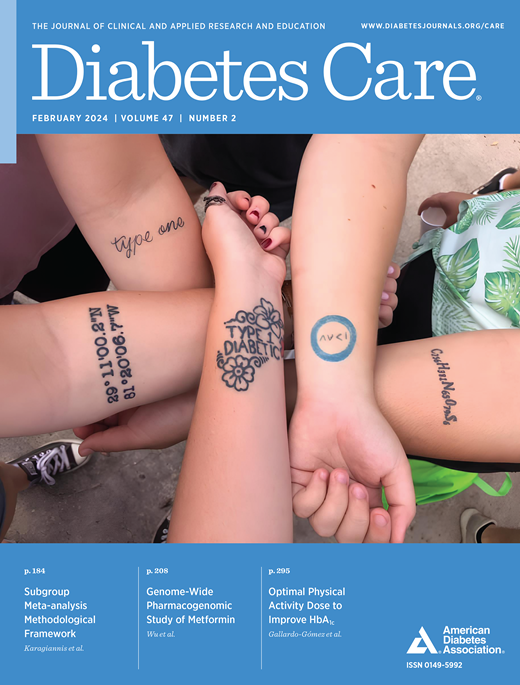细胞与非细胞基质产品治疗糖尿病足溃疡:真皮和绿洲纵向比较疗效研究(DOLCE) -一项随机临床试验
IF 16.6
1区 医学
Q1 ENDOCRINOLOGY & METABOLISM
引用次数: 0
摘要
目的探讨细胞基质(CM)产品是否比非细胞基质(ACM)产品能更好地治疗未愈合的糖尿病足溃疡。研究设计与方法皮肤移植与绿洲纵向疗效比较研究(DOLCE)是一项随机、单盲、三臂对照试验。纳入符合纳入/排除标准的糖尿病足溃疡全层未愈合患者(年龄≥18岁)。结果169例符合条件的患者中,138例入组,117例随机分配。在12周内,患者接受标准护理(SOC)、CM或ACM。主要观察指标为12周伤口愈合率。117名参与者中,CM组41人,ACM组48人,SOC组28人。有21人退出,但有7人达到了第一个主要终点。在117名参与者中,有59%的人在12周内溃疡完全再上皮化:CM组49%,ACM组69%,SOC组57% (χ2检验P = 0.16)。28周时,CM组25例(61%),ACM组27例(56%),SOC组18例(64%)愈合(P = 0.78)。两组间伤口再犯和不良事件发生率无差异。结论SOC、ACM和CM的疗效无差异,提示SOC可减轻糖尿病足溃疡治疗的经济负担。本文章由计算机程序翻译,如有差异,请以英文原文为准。
Cellular Versus Acellular Matrix Products for Diabetic Foot Ulcer Treatment: The Dermagraft and Oasis Longitudinal Comparative Efficacy Study (DOLCE)—A Randomized Clinical Trial
OBJECTIVE To determine whether cellular matrix (CM) products result in better healing rates than acellular matrix (ACM) products for nonhealing diabetic foot ulcers. RESEARCH DESIGN AND METHODS The Dermagraft and Oasis Longitudinal Comparative Efficacy Study (DOLCE) was a randomized, single-blinded, three-arm controlled trial. Patients (aged ≥18 years) with a full-thickness nonhealing diabetic foot ulcer who met inclusion/exclusion criteria were enrolled. RESULTS Of 169 eligible patients, 138 were enrolled and 117 randomly assigned. For 12 weeks, patients received standard of care (SOC), CM, or ACM. The primary outcome was the percentage of wounds healed by 12 weeks. Of the 117 participants, 41 were in the CM group, 48 in the ACM group, and 28 in the SOC group. There were 21 withdrawals, but seven had reached the first primary end point. Complete re-epithelialization of the ulcer by 12 weeks occurred in 59% of the 117 total participants: 49% in the CM group, 69% in the ACM group, and 57% in the SOC group (P = 0.16 by χ2 test). At 28 weeks, 25 participants (61%) in the CM group, 27 (56%) in the ACM group, and 18 (64%) in the SOC group had healed (P = 0.78). No differences were found in wound recidivism or adverse event occurrence between groups. CONCLUSIONS No difference in efficacy was found between SOC, ACM, and CM, suggesting that SOC can reduce the economic burden of diabetic foot ulcer treatment.
求助全文
通过发布文献求助,成功后即可免费获取论文全文。
去求助
来源期刊

Diabetes Care
医学-内分泌学与代谢
CiteScore
27.80
自引率
4.90%
发文量
449
审稿时长
1 months
期刊介绍:
The journal's overarching mission can be captured by the simple word "Care," reflecting its commitment to enhancing patient well-being. Diabetes Care aims to support better patient care by addressing the comprehensive needs of healthcare professionals dedicated to managing diabetes.
Diabetes Care serves as a valuable resource for healthcare practitioners, aiming to advance knowledge, foster research, and improve diabetes management. The journal publishes original research across various categories, including Clinical Care, Education, Nutrition, Psychosocial Research, Epidemiology, Health Services Research, Emerging Treatments and Technologies, Pathophysiology, Complications, and Cardiovascular and Metabolic Risk. Additionally, Diabetes Care features ADA statements, consensus reports, review articles, letters to the editor, and health/medical news, appealing to a diverse audience of physicians, researchers, psychologists, educators, and other healthcare professionals.
 求助内容:
求助内容: 应助结果提醒方式:
应助结果提醒方式:


